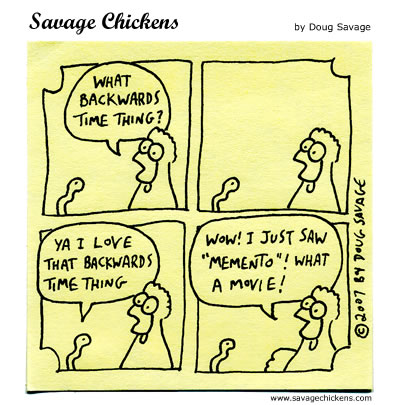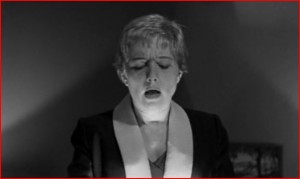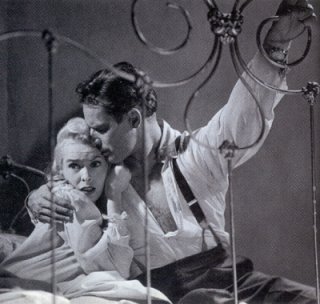Sorry for the delay in the post guys, but here we go!

According to Wikipedia’s article on the famed Pandora’s Box, “Pandora had been given a large jar and instruction by Zeus to keep it closed, but she had also been given the gift of curiosity, and ultimately opened it. When she did so, all of the evils, ills, diseases, and burdensome labor that mankind had not known previously, escaped from the jar, but it is said, that at the very bottom of her jar, there lay hope.” Now, such myths, in collaboration with the biblical tale of Eve tempting Adam to partake of the forbidden apple, have characterized women as the downfall of mankind. This concept, in my opinion, has had a significant impact on the media and all forms of art ranging from painting, sculpture, drawing and, in our study, film. What I speak of is the prominence of the femme fatale character in the films we have studied thus far. Whether it is Elsa Bannister from the Lady of Shanghai (1948), Gilda from Gilda (1946), or Laura from Laura (1941), women are shown to stir the emotions of and expose the vulnerabilities in the male leads. Furthermore, our reading of Laura Mulvey demonstrated that women are also display pieces that satisfy our scopophilic urges whether we view them from the perspective of an audience member or look through the eyes of the cast. Film’s paternalistic roots have made it such that women are primarily objectified and, in the instances in which they demonstrate power, they do so out of self-interest and treachery. We have bought so far into the idea that, a “strong woman” is viewed as a woman who behaves like a man.
In the Lady of Shanghai, through her beauty and feminine charm, as well as her ability to portray herself as a damsel in distress, Elsa uses Michael and George as tools to further her own agenda, eventually leading to Michael’s imprisonment. In Gilda, Gilda provokes Johnny to no ends, compromising his position and causing him to act irrationally. You see the rage that arises on his face each time she enters the room and, despite his attempts to be apathetic, he acts out of spite. Though the film has a happy ending, Gilda has an overall negative effect on the male protagonist. In Laura, a calculating and overly logical human being, Walso, is transformed into a possessive and jealous man for love of the fair Laura. Though it can be argued that his own ego is his downfall, even Laura herself seems to feel that she is, at least partially, the source of his demise. In all these films, women have a severely negative impact on the behavior of the male lead, despite their intentions. Their power is apparent only as far as they can exert influence on the male characters, as they are shown to have no direct control of their own. Viewing the films in this light, as is commonly done in film noir, however, would be a mistake. There is greater complexity to the roles, as is discussed by Julie Grossman’s piece, Film Noir’s “Femme Fatales,” Hard-Boiled Women: Moving Beyond Gender Fantasies. She explains how our characterizations of woman limit the ways in which we view them in society and shows us the necessity of reassessing the concept of gender. Women are to be seen as they are as human beings, beyond the constructed ideal that has been imposed upon them.
It was very interesting when, in class, we found it extremely difficult to name strong female characters that did not demonstrate traits we found to be classically male. I believe this is rooted in a tradition of male defined social roles. We must realize that social dynamics are products of the people of their time. There is no male or female trait until we ascribe value to an abstract feature, whether it is sensitivity or apathy, or passiveness or forcefulness. These are just features of human beings that have been accepted as defining one sex or another for so long that we have become accustomed to them. Despite the revolution in thinking brought about by the feminist movement and the civil rights movement, our mainstream film has lagged behind the times. If only the hope found at the bottom of Pandora’s Box could lead to film representing the true HUMAN condition.
I would love to hear all of your thoughts on this issue.






















 speak of, a subject that was taboo in any social setting. It was thought of as a topic that would corrupt society and therefore limitations were placed on what film producers could and couldn’t do when depicting relationships. Married couples were often shown sleeping on different beds, and any implications of sex were considered scandalous. Scenes such as that in Double Indemnity where Phyllis come out covered only in a blanket, or the scene ended shortly after a kiss which leave the rest to the audiences imagination were seen as pushing the limit. In the film noir films we have viewed in class anybody having a relationship with a woman can almost certainly be expected to die. This holds true whether the women is a femme fatal as Phyllis in Double Indemnity, Gilda in Gilda, and Elsa from Lady from shanghai or a wholesome woman such as Polly from D.O.A. Men who fall for these women all end up dead or in a non idealistic situation. I believe that by doing this the intended message to the audience is that women and relationships will lead to your downfall. Movies such as these are meant to promote purity, because of the fear that sex will corrupt the minds of society. Although the portrayal of sex in films has come a long way from the film noir period the fear of sex and portrayal of sex as negative is still visible today. Modern films will show acts of sex but they do so in a way that still carries on the message th
speak of, a subject that was taboo in any social setting. It was thought of as a topic that would corrupt society and therefore limitations were placed on what film producers could and couldn’t do when depicting relationships. Married couples were often shown sleeping on different beds, and any implications of sex were considered scandalous. Scenes such as that in Double Indemnity where Phyllis come out covered only in a blanket, or the scene ended shortly after a kiss which leave the rest to the audiences imagination were seen as pushing the limit. In the film noir films we have viewed in class anybody having a relationship with a woman can almost certainly be expected to die. This holds true whether the women is a femme fatal as Phyllis in Double Indemnity, Gilda in Gilda, and Elsa from Lady from shanghai or a wholesome woman such as Polly from D.O.A. Men who fall for these women all end up dead or in a non idealistic situation. I believe that by doing this the intended message to the audience is that women and relationships will lead to your downfall. Movies such as these are meant to promote purity, because of the fear that sex will corrupt the minds of society. Although the portrayal of sex in films has come a long way from the film noir period the fear of sex and portrayal of sex as negative is still visible today. Modern films will show acts of sex but they do so in a way that still carries on the message th at sex and relationships will lead to your down fall. In most horror films those shown having sex will die shortly after, the typical lone survivor will be the virgin of the group. A perfect example of this would be Friday the 13th (2009) where basically everyone dies in aright before, during, or after committing a sexual act. This theme of the virgin surviving exposes Americas still existent fear of sex. Although I do not have a problem with the production of films today I find it interesting how America projects sex in films as negative but allow other things which may have a greater impact on society such as crime and violence. I believe violence in movies is something that also has a great chance of corrupting the minds I would say even greater then sex and find it interesting that America has never made as big a deal about it.
at sex and relationships will lead to your down fall. In most horror films those shown having sex will die shortly after, the typical lone survivor will be the virgin of the group. A perfect example of this would be Friday the 13th (2009) where basically everyone dies in aright before, during, or after committing a sexual act. This theme of the virgin surviving exposes Americas still existent fear of sex. Although I do not have a problem with the production of films today I find it interesting how America projects sex in films as negative but allow other things which may have a greater impact on society such as crime and violence. I believe violence in movies is something that also has a great chance of corrupting the minds I would say even greater then sex and find it interesting that America has never made as big a deal about it.
 In Kiss Me Deadly, almost all who sought to retrieve the case ended up dead. Mike Hammer only survived after realizing that its contents are more serious than he could handle alone, and that he should hand it over to the police, thereby ending his desire for the box. While the contents of the case are never revealed, it is assumed to be a kind of dangerous atomic energy. Released during the Cold War, this movie is an example of the public’s general fear of a nuclear apocalypse.
In Kiss Me Deadly, almost all who sought to retrieve the case ended up dead. Mike Hammer only survived after realizing that its contents are more serious than he could handle alone, and that he should hand it over to the police, thereby ending his desire for the box. While the contents of the case are never revealed, it is assumed to be a kind of dangerous atomic energy. Released during the Cold War, this movie is an example of the public’s general fear of a nuclear apocalypse.


 In Martin Scorcese’s 2006 crime film The Departed we are introduced to William Costigan, played by Leonardo DiCaprio, who is an undercover cop working for Frank Costello the Irish Mob boss from Boston, played by Jack Nicholson. Then we also have Colin Sullivan, played by Matt Damon, who acts as Costello’s inside man in the police department. Throughout the film each of these characters elicit fear, anxiety and paranoia. The character that most strongly feels these emotions is DiCaprio’s William Costigan. Costigan is introduced to the dark, demented world that is the Irish mob. Every day he fears for his life, thinking any minute it could be his last. His anxiety and paranoia strengthens so much so he begins going to therapy and taking prescription drugs. He feels that either Costello is going to find him out or that his own police force is going to give up on him and allow him to rot in the depth of the criminal underworld.
In Martin Scorcese’s 2006 crime film The Departed we are introduced to William Costigan, played by Leonardo DiCaprio, who is an undercover cop working for Frank Costello the Irish Mob boss from Boston, played by Jack Nicholson. Then we also have Colin Sullivan, played by Matt Damon, who acts as Costello’s inside man in the police department. Throughout the film each of these characters elicit fear, anxiety and paranoia. The character that most strongly feels these emotions is DiCaprio’s William Costigan. Costigan is introduced to the dark, demented world that is the Irish mob. Every day he fears for his life, thinking any minute it could be his last. His anxiety and paranoia strengthens so much so he begins going to therapy and taking prescription drugs. He feels that either Costello is going to find him out or that his own police force is going to give up on him and allow him to rot in the depth of the criminal underworld.
 Walter O’Neil of “The Strange Love of Martha Ivers” is one of the weakest male characters I have ever encountered. His anxiety is like a dark cloud hovering over the film. I feel anxious just watching Walter. In fact, Walter acts as a doormat for his father, Martha his wife, and his childhood friend Sam.
Walter O’Neil of “The Strange Love of Martha Ivers” is one of the weakest male characters I have ever encountered. His anxiety is like a dark cloud hovering over the film. I feel anxious just watching Walter. In fact, Walter acts as a doormat for his father, Martha his wife, and his childhood friend Sam.